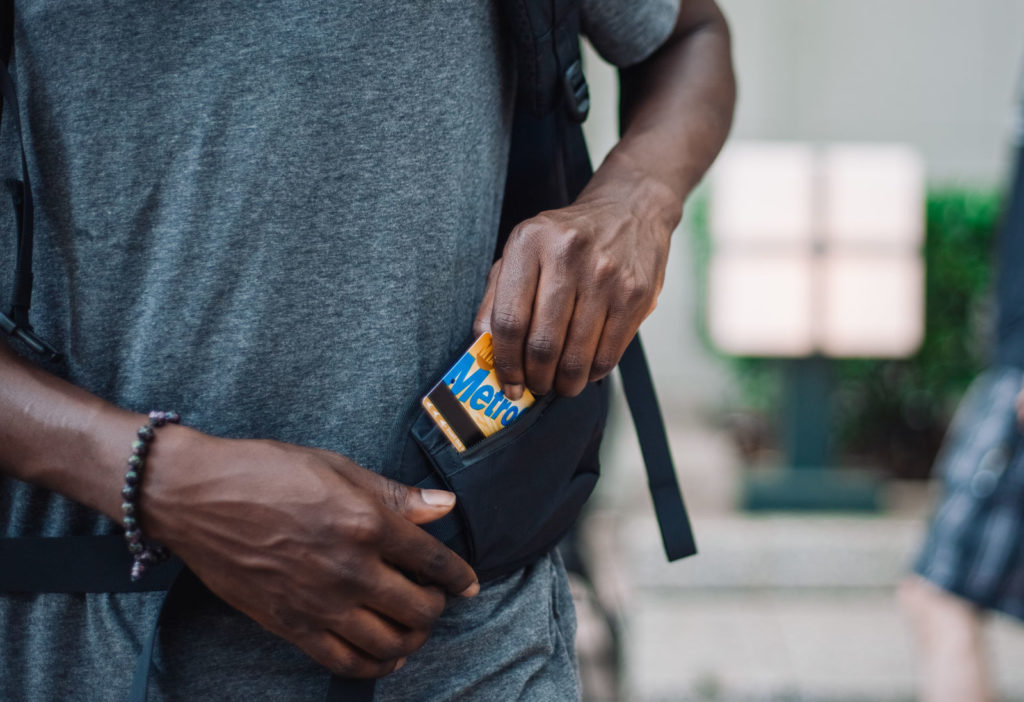Why a Hip Belt is a Necessity for a Comfortable Backpack

The Tortuga Promise
At Tortuga, our mission is to make travel easier. Our advice and recommendations are based on years of travel experience. We only recommend products that we use on our own travels.
Table of Contents
Remember in high school when everyone wore their backpacks by a single shoulder strap? We were all too cool to wear two straps. One strap was plenty to carry a bunch of heavy books on your small frame… right?
Thankfully, we grew up and started caring about our bodies. Except for one thing…
I still see travelers with their backpack’s hip belt dangling around their legs. Their overworked shoulders sag under the weight of their bags. They dismiss the hip strap on their bag as inconvenient or unflattering.
A good hip belt is a requirement for a comfortable
Pack for trips of one week or more without checking a bag.
- Thick comfortable straps
- Easy to organize
- Durable, waterproof fabric
- Backed by our Worldwide Warranty
Airlines allow
All of Tortuga’s travel backpacks have hip belts. We feel strongly that this is the right design. This article will explore why hip straps are so important that we include them on all of our large packs. We do not include belts on our smaller, personal-item-sized bags. I’ll explain the reasoning for both decisions later in this article.
Now, let’s save your shoulders. If you already know why you need a hip belt, you can skip ahead to the section on how to fit your backpack’s belt for maximum comfort.

Why Your Backpack Needs a Hip Belt
Let’s set travel gear aside for a moment. Take a look at hiking backpacks, which are often larger and heavier than travel bags.
Every hiking backpack has an advanced suspension system including a padded, weight-bearing hip belt.
Without carry on limits to adhere to, hiking backpacks are larger than travel backpacks. Large hiking packs are also heavier after they’re packed with food, clothes, camping equipment, and other supplies. Outdoor companies are experts at making these huge, heavy bags feel light enough to carry over many miles and many days.
The most important part of the suspension system on these bags is the belt. This strap is meant to transfer your pack’s weight from your shoulders to your hips.
A hip belt can transfer up to 80% of your pack’s weight from your shoulders to your hips, according to Outdoor Gear Lab. Would your shoulders feel better if your pack felt 80% lighter?
With this number in mind, not using your hip belt seems ridiculous.
Our friend Travis at Extra Pack of Peanuts covered this topic in a podcast episode on choosing the right backpack.
At the max
Transferring your pack’s weight from your shoulders to your hips lets your stronger leg muscles—not your weaker shoulder muscles—do the heavy lifting.
We built Tortuga’s travel backpacks to maximize
We included a hip belt on our original list of “must have” features when we designed our first backpack in 2009 and haven’t taken it off the list since then. A full-sized
If you disagree, just detach the belt. All Tortuga hip belts are removable.
Our smaller laptop backpack does not have a hip belt. At 27L, this bags is smaller and lighter—even when packed—than a full-sized

What Makes a Good Hip Belt?
When shopping for travel backpacks, make sure to look closely at the hip strap on your favorite bag. Some bags claim to have a hip belt, but the belt is only a flimsy piece of webbing.
Webbing straps don’t transfer any weight. Those straps only hold your bag against your body. They are for stability, not weight distribution.
A
A wider hip belt is good because it will distribute your bag’s weight over a wider area of your body instead of digging into your waist and hips. However, a hip belt can also be too big. Make sure not to buy one that overwhelms your midsection.
When shopping for a
- Is 2″ wide or larger
- Has soft foam for comfort
- Has pockets for storage
- Uses high-quality webbing and buckles
- Is included with your backpack
Make sure that your backpack includes a belt. Some companies leave off this necessity to make you buy the belt separately. They try to make their prices look lower then force you to upgrade to avoid the pain and discomfort of carrying your bag without a hip strap. We disagree with this approach.
Our job is to make travel easier, not to copy the airlines’ deceptive pricing schemes.
Now that we’ve covered why you need a hip belt and our hip belt design decisions, let’s discuss how to adjust one for maximum comfort.
How to Fit Your Hip Belt
Your hip belt won’t do anything if your bag doesn’t fit correctly. Just buckling the strap isn’t enough.
Let’s cover how to fit and adjust your pack, including the hip belt.
Measure Your Torso
To measure your torso, ask a friend for help. All you need is a soft tape measurer.
- Tilt your head forward to find your C7 vertebra, the one that sticks out at the base of your neck.
- Find the top of your hip bones, also known as your iliac crest. Place your hands flat with your fingers pointing forward and thumbs pointing backward. Your hands will form a “shelf” that your backpack will rest on.
- Have a friend measure the distance from your C7 vertebra to the top of your hip bones.
That distance is your torso length. You can use that length to buy the right backpack for you. Backpacks with hip belts will include sizing information, whether the bag is one-size-fits-all, small/medium/large, or fully adjustable.
A backpack that is too short or too tall for your torso will be uncomfortable and won’t transfer the bag’s weight correctly. The hip belt must sit on your hips. Otherwise, you won’t get the full benefit of your suspension system.
Now that you’ve measured your torso and found a backpack in your size, you can load up your bag for a test pack and get the perfect fit.
Adjust Your Backpack’s Fit
Remember that you are adjusting the hip belt. Your hips and legs are doing the work. This is not a waist belt. Your waist can’t carry anything.
The hip belt should rest on the top of your hip bones. Depending on the height of your hip belt, the buckle should be roughly on top of your belly button.
Start there then adjust the position and fit until it is comfortable.
Hip belts can carry up to 80% of your pack’s weight. When you’ve adjusted the belt correctly, you’ll know it. The weight will move off of your shoulders. You’ll feel the weight on your hips. The shoulder straps will be carrying some weight but will mostly be holding the pack against your body.
The feeling is like magic. If you aren’t sure, you don’t have it right. This sounds crazy to people who have never used a hip belt before. When you get it right for the first time, you’ll have the same “aha” moment that I did.
Now that you know why hip belts matter and what to look for in a hip belt, you can start searching for the perfect
Pack for trips of one week or more without checking a bag.
- Thick comfortable straps
- Easy to organize
- Durable, waterproof fabric
- Backed by our Worldwide Warranty
We designed the Travel Backpack by Tortuga for maximum comfort. The suspension system is fully adjustable to fit nearly any height and torso length. The padded hip belt will transfer your pack’s weight from your shoulders to your ships for a comfortable carry. You can use the spacious hip belt pockets for your phone, ticket, or anything else you need at your fingertips.





